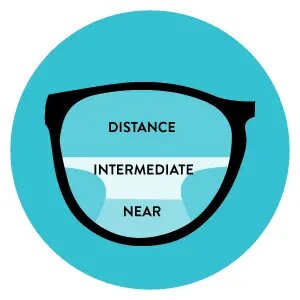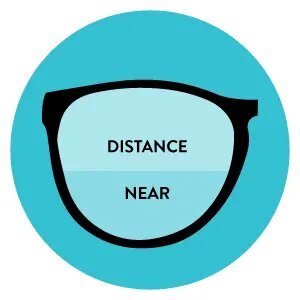If you are 40 something and facing problems in reading fine prints with your current glasses, then you could be suffering from a condition called Presbyopia. Derived from a Greek word meaning ‘old eye’, Presbyopia is caused by the hardening of the lens making it difficult to switch focus between objects close-up and far away. The good news is that there are plenty of lens options available at Titan Eyeplus for you to choose from.

WHAT ARE PROGRESSIVE LENSES?
Progressives are multifocal lenses with three viewing areas – distance, intermediate and near vision. As they do not have visible lines dividing each area, these lenses may be mistaken for traditional single vision glasses and so are sometimes called no-line bifocals.
These lenses are usually prescribed to people who already use spectacles for distance vision but now require an increase in the quality of near vision for reading and intermediate vision for tasks like using a computer. Instead of carrying three pairs of glasses, progressives offer an all-in-one convenience. Made to provide a gradual transition of vision from top to bottom without any visible lines, the upper section of the lens – the primary viewing area is for distance vision while the bottom section is for near vision leaving a sliver in the middle for intermediate vision.
If you’re looking for progressives, here’s what’s on offer:
- Standard Progressive Lenses: These are standard lenses and do not cost much more than normal Bifocals. A fairly wide reading area is available in Standard progressive lenses but you will have to choose from bigger lenses that fit the vertical distance required for your eyes to travel between distance vision and reading.
- Computer Progressive Lenses: For the ease and comfort of working at a computer, these lenses are for you. These are also called ‘office lenses’ and can provide clear vision between 16 inches and 6 feet. These lenses are great for clear vision at intermediate and near distance.
- Short Corridor Progressive Lenses: These lenses are especially for fashion-forward consumers. It offers the same seamless transition between distance vision and reading but in smaller frames.
- Premium Progressive Lenses: As the name suggests, they are premium lenses & offer a distortion-free reading area that extends farther both left and right. These lenses are customized so that all ranges of power fit nicely into any frame. They are generally much easier to get adapted to.

WHAT ARE BIFOCAL LENSES?
Bifocal lenses are made up of two parts – the top half for farsightedness and the bottom half for nearsightedness. The two sections of the lens are separated by a visible line called the bi-focal line. The segment of the lens devoted to correcting near vision can be in several shapes including a half-moon shape (D-bifocal) & round segment (Kryptok bifocal).
With only two zones of vision, bifocal lenses do not have an intermediate zone of vision, hence they cannot be used for tasks like working at a computer. However, some people find it difficult to get adapted to bifocals because the top and bottom areas of vision correction are so different. The trick to that is to slowly train your eyes to adjust to the “image jump” that occurs at the intervening line between distance and reading areas. The best thing to do for this is to wear them consistently so your eyes adjust quickly.
PROGRESSIVES VS. BIFOCALS
- For a more natural correction of presbyopia, progressive lenses are much more preferred over bifocals. Bifocals have just two powers – top half for distance vision and lower half for near vision. Whereas, there is a gradual seamless change in power from distance to near vision in progressives providing many focal points satisfying almost any visual need.
- Progressive lenses don’t have “image jump” problems, unlike bifocals. It creates a smooth and comfortable transition from distance to near and back. The “image jump” problem in bifocals occurs at the visible line between distance and reading areas creating problems in clarity and apparent position of objects when your eyes move across the visible lines.
- Since bifocals are usually associated with old age, progressive lenses would look better and give you a more youthful look because there are no visible lines across the lenses.
- Progressive lenses are technologically superior to bifocals and do cost more because basically, you are getting three eyeglasses in one. Given the convenience and simplicity, as described above, progressive lenses are a better choice and worth that bigger investment.
With bifocals and progressives having their benefits and drawbacks, we suggest heading to one of our stores and talking to a qualified Titan Eyeplus consultant so we can help you make the right decision of what kind of lenses will suit your lifestyle best.



